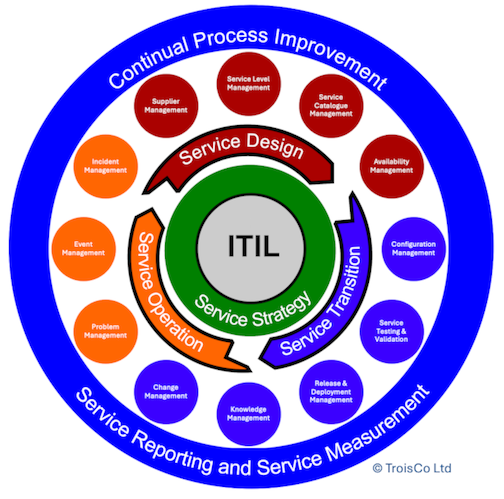ITIL Service Transition

This section of the article is designed to offer an in-depth look at the Service Transition phase, emphasizing its importance in safely and efficiently introducing new or changed services. It guides the reader through understanding the necessary frameworks and best practices to mitigate risks and ensure a smooth transition process.
Introduction to Service Transition
Service Transition is the third phase of the ITIL service lifecycle. This phase is critical for the successful deployment and adoption of new or changed services within an organization’s live environment. It aims to ensure that changes to the service and service management processes are carried out in a coordinated, efficient, and risk-averse manner.
Purpose and Goals of Service Transition
The main purpose of Service Transition is to manage service changes and deployment effectively while minimising the risk of disruption to the existing service operations. Key goals include:
- Ensuring that new or changed services are tested and meet customer expectations.
- Making certain that the service can be operated, managed, and supported in accordance with business requirements.
- Protecting the integrity of existing services while implementing changes.
Key Processes in Service Transition
- Change Management: Manages changes to the IT services, ensuring that risks have been assessed and mitigating actions are in place. This process seeks to enable beneficial changes to be made with minimum disruption to IT services.
- Knowledge Management: Aims to gather, analyze, store, and share knowledge and information within an organization. The primary purpose is to improve efficiency by reducing the need to rediscover knowledge.
- Release and Deployment Management: Plans, schedules, and controls the movement of releases to test and live environments, ensuring that the integrity of the live environment is protected and that the correct components are released.
- Service Asset and Configuration Management (SACM): Involves maintaining information about Configuration Items (CIs) required to deliver an IT service, including their relationships. This process ensures that only authorized and identified configuration data is used in service provision.
- Transition Planning and Support: Plans and coordinates the resources to ensure that the specified requirements of Service Strategy and Service Design are met.
Challenges in Service Transition
Implementing Service Transition effectively can be challenging due to:
- The complexity of environments and the need for coordination across multiple teams.
- Balancing the need for change against the potential impacts of change.
- Ensuring that all stakeholders understand and commit to the transition plans.
Best Practices for Effective Service Transition
- Thorough Testing: Implement rigorous testing processes to ensure that services meet requirements and do not adversely impact existing services.
- Detailed Documentation: Maintain comprehensive documentation to ensure that every aspect of a service and its deployment is recorded and retrievable.
- Stakeholder Engagement: Engage with all stakeholders early and often to ensure their requirements are understood and considered during the transition process.
- Post-Implementation Review: Conduct reviews after each deployment to gather learnings that can improve future transitions.
The Role of Automation in Service Transition
Leveraging automation can significantly enhance the efficiency and accuracy of service transitions. Automated tools can be used to manage and track changes, test services, and deploy updates, reducing the potential for human error and speeding up the process.
Automation toolset
In today’s fast-paced tech landscape, integrating Continuous Integration (CI) and Continuous Delivery (CD) into service management isn’t just beneficial – it’s essential.
- CI is all about integrating code changes frequently and automatically testing them. Automated test cases for both new and existing code are needed.
- CD takes the baton from CI and automates the release process, streamlining service delivery automatically to test environment and production.
We will dive deeper into CI and CD in a specific article later in this series on Service Management.
#ITIL #ITSM #ITserviceManagement #BestPractices #TechTalk
